QuestionQUESTION: Hi
Thank you for making yourself available to people like myself who have questions on reptiles. It is appreciated.
I have some questions on terrariums and glass tanks. I own two juvenile three month old male and female bearded dragons. I purchased them about 3 weeks ago. They are in a 40 gallon breeder tank with a 75 watt dome basking light 6-8 inches away from the highest branch and a repti-glo 5.0 florescent light that is 18 inches long. I ordered a Powersun Mercury Vapor Bulb with a 10 inch fixture for them, which will take the place of the other lights. Both have their own decor' in the tank and get fed crickets separately 3x daily. I dust them at each feeding with calcium and herpavite supplements. I feed them the recommended greens mixed with juvenile dragon food. They get sprayed 2x daily and bathed 3-4x weekly. I would really prefer to keep them in the same enclosure if possible. This is why I want to take all proper precautions in doing so. Separate decor, huge new tank, separate feeding, and separate basking spots are examples. I realize that once maturity hits breeding will follow and if I have a big enough tank, I could divide it for the both of them.
My question in regard to upgrading to a tank or terrarium has to do with pricing and convenience. I found a 180 gallon wide terrarium on a site called glasscages.com for 300 dollars. It measures 72 long by 24 wide by 24 high. With shipping to Long island it costs another 100 dollars. I looked at a 125 gallon tank in the petstore for 300 dollars. It measures 72 long by 18 wide by 22 high. So basically, my question to you is, what is the most ideal tank for two bearded dragons? What are the most important measurements for them as far as length, width, and height? I understand that as juveniles a huge tank may be too stressful for them. I just want to buy their adult home now and if they are put into it as juveniles I could always put a divider in to make it smaller until then. So whether I purchase a terrarium or aquarium tank, which size tank is the best tank possible for them?
Well, this should pretty much cover my questions, lol. I hope I did not sound too repetitive with anything.
Thank you so much for your time and help. I really appreciate any advice and information you have to offer me.
Have a great day!
Derek
ANSWER: Hi Derek,
Wonderful questions!! And its wonderful to see all teh home work you have done on beardies...
Basically, you need to have no less than 4 sq feet of FLOOR SPACE per dragon. This would amount to something that is at least 7 ft long. They need more floor space than they do height.
You are correct on the stress with too much space for babies..but juvy stage, they can have more room...
You may want to think of ordering the cut pieces and frame vs the ready made tank from glasscages. It will most likely be cheaper on both cost and shipping. Also, if you are handy, check out my webshots page, folder habitats...a few of my cages are made with old storm windows or window sashes...basically free or very very low cost. To find old windows...people doing remodeling are generally looking to get rid of them. Setting up separate areas for each beardie is highly recommended..and...most beardie owners will tell you that they should not be housed together on a "forever" basis as that they will breed too young, which can cause severe health issues with both sexes. Also, the stress related to breeding, etc. People that breed good, healthy beardies only place the female with the male for a short period of time during breeding season.
I'm including my basic care sheet. Please read the section on LIGHTING carefully. Your best UVB to use are the Mega Ray...they are fantastic..its what I use on my iguanas. The POWERSUNS are not doing the job they say they are doing with uvb output...please read the links in the lighting section. Also, the repti glo 5% aren't giving off the needed uvb for beardies. BUT!!! both are acceptable for additional lighting ..just not for needed UVB.
BASIC BEARDED DRAGON CARE:
HOUSING:
For an adult bearded Dragon, a 50 -55 gallon is the smallest recommended tank. For a baby, nothing less than a 30 gallon tank will work for a very short time, so its best to just start out with the adult sized tank....you can add rocks and branches for climbing, being sure to not stack rocks too high to prevent them toppling over. Branches need to be secure. They like to have a hide log or cave too!! All items brought from outside need to be cleaned well before placing them in the BD's tank. To clean them, there are a few methods: to wash in a bleach solution of 1/4 cup of bleach to 1 gallon of water. Let them soak for about an hour, rinse them in hot water several times and then let them dry in the sun until completely dry. If the items are small enough, they can be baked in an over at 200 degrees for about 2 hours, check often to be sure they are not starting to burn. The items can also be boiled(simmered) for 30 minutes or so and then allowed to dry completely before
placing in the tank. I also suggest washing any pet store items such as caves, rocks, branches, etc before placing in the tank as that if the store would happen to have mites they can also be on the items we purchase. Any of the above methods are acceptable for cleaning. CAUTION!!! On store bought branches...be VERY careful with the driftwood pieces that have the holes in them!!! Be sure the holes are small as that if the holes are large, the BD MAY be able to get his head in them but not able to get it back out!!! A secure screen top is necessary for bearded dragons as that also they do not require much height for climbing..they can and do climb!! NEVER USE HEAT ROCKS OR HEATED CAVES!!! They malfunction and cause severe burns and even death!!!!
SUBSTRATES:
Young bearded dragons MUST be kept on paper towels, newspaper or other non particulate(loose) substrate to prevent them from getting any loose substrate into their mouth and swallowing it which can and does cause intestinal blockages.Once the BD is over 10 inches, some people have had good luck using play sand mixed with 50% of peat moss. I prefer the safe substrate of the newspaper, or other non particulate substrate to prevent any problems and also for ease of cleaning.
LIGHTING:
BD's need UVB, which is the special lights that come in fluorescent tubes or special screw in bulbs
(mercury vapor)that are designed to produce uvb and heat. The tubes do not produce heat. UVB is needed by the BD
to be able to absorb the calcium in the foods they eat. Without the uvb, they will develop metabolic bone disease.
With the tubes, they must say that they produce BOTH uvb and uva. The uvb needs to be 5% or higher. Repti Sun 5.0 and 10.0(not compact) are TWO of the best uvb tubes on the market. The repti glo 8.0's are a great uvb source also. Arcadia 5.0 (UK), which is the uvb tube available in the UK is a good uvb tube. These need to be positioned 6-8 inches(for the 5.0 and 8.0 and 8-10 inches for the 10.0) over the BD so that they get the uvb that is needed. Recommended length of the tube is 24 inches or more. They need to be replaced every 6-9 months as that they stop producing uvb long before they stop producing light. They need to have access to uvb and basking temperatures for 10-12 hours daily. At night, no white lights!!! There has been new studies that have proven that compact uvb lights, both the spiral/coil type and the ones that look like long "U's" laying on their side and a few other brands are causing what basically amounts to snow blindness in reptiles. To read more on this, you can go to
http://www.uvguide.co.uk/index.htm Here is a link to a letter from RZilla on their product: http://www.zilla-rules.com/assets/006/13278.pdf
There are tubes and bulbs that say ''full spectrum'' but they do not produce any uvb.
On the mercury vapor , they also produce heat. They also produce the uvb and uva. The best on the market now are the
MEGA RAY or the T-Rex. www.reptileuv.com has more information on the Mega Ray lights. When using these, the distance is much greater
than the uvb tubes and the directions must be followed that
are listed for the light. When using the mercury vapor
lights, you don't need to have one light for uvb and one for
heat. The Mercury vapor lights provide both.
HEATING AND TEMPERATURES:
Bearded Dragons have specific temperature requirements. For heat when using the uvb producing fluorescent tubes, a regular household lightbulb will work for DAYTIME heat. The wattage needed will vary to each situation such as tank size, room temperatures, air flow. Their basking area temperature must be between 95F and 105F degrees to allow proper digestion of food. Your basking area must be where the uvb light is as well as the heat source. Be sure that the BD cannot get too close to the heat source as that they WILL get burned! The ambient temperature range in the mid 80's . Cool daytime range of normal room temperature of low to mid 70's. Nighttime temperatures in the low to mid 60's is fine. NEVER USE HEAT ROCKS!!!!!!!!!!!!!!!!!!!!! A good digital thermometer is a must. I like using the duel ones with the probe...cost about 15$ at Wal Mart. The probe can be placed in the basking area at the BD's level to monitor this temperature and the main unit can be placed in one of the ambient temperature areas. When reading them, the "out" reading is the probe area.
DIET:
Bearded Dragons eat and need both animal proteins and vegetable matter!!! As young dragons they eat a bit more of the insects. As they get older, as adults their diet is more of the vegetable matter. As young BDs, the diet is about 80% animal proteins and 20% vegetable matter. As they get older, the ratio changes. An adult will eat about 80%-90% vegetable matter and 10-20% animal proteins.
Animal protein sources are: Crickets, superworms, silkworms, roaches, hornworms, waxworms. Waxworms are considered candy to a BD so only feed on occasion in a small amount(2-3 worms). ALL insects must be properly gutloaded for at least 48 hours prior to feeding to the dragon. For crickets and superworms, this can be done with vegetables, plain cereals and commercial foods for the species. Silkworms and the other insects have their own diet needs. Its best to feed the crickets in a separate feeding tank such as a 10 or 20 gallon size tank or container with a well vented lid. This can make it easier for the dragon to catch the crickets and prevents any stray crickets in their "home" tank from deciding to nibble on the BD if he happens to not find them all. If you do feed in his home tank, be sure to place a 1/2 potato in the tank to help prevent the crickets from biting at the BD.
ALL insects fed must be no larger than the space between their eyes to prevent choking. Be sure to dust the insects daily(for dragons up to 14-15 inches) (2x wkly there after)with a good calcium source such as Rep Cal calcium powder with no added Phosphorus. Young BD's up to 4 months of age will eat more crickets than anything. At this age they will usually consume anywhere from 10 to 30+ correctly sized crickets three times a day. Be sure to remove any uneaten crickets that are not consumed in a 15-25 minute time frame. For this reason, its easier to use a separate feeding tank for the bearded dragon. A 10 gallon tank(with a screen top) works well. Its best to offer their "salad" of greens/veggies before offering their morning insect feeding when they are hungry to prevent any problems with them preferring NOT to eat their salad. Their salad consists of Collard greens, mustard greens, turnip greens, dandelion greens...... this is the BASE of the green part of their vegetable diet. To this, for variety you can add arugula, escarole, endive,small amounts of bok choy or other Asian greens. For the vegetable part of the diet, green beans, butternut squash, acorn squash(other winter squashes are also acceptable) yams, sweet potato. For color, sweet peppers can also be added in a small amount. For baby BD's, using a food processor for the greens and veggies works well. As they get older, greens should never be larger than about an inch x an inch in size. Never feed lettuces as they have no nutritional value. The hard veggies should be either food processed or grated. Fruits can also be offered in small amounts. Good fruits are figs, papaya, melon, blueberries, strawberries, raspberries....and many other fruits... these need to be mashed or chopped. Watermelon is a good source of water for the dragon. Their salad can be dusted once or at the most, twice a month with a good vitamin supplement such as RepCal HerptiVit. This is by no means a complete list of foods the dragons can eat.
You can also offer baby food chicken or small bits of boiled chicken.
Be sure to provide a dish of FRESH drinking water at ALL times!!! Misting their salad will also help get much needed water into them. NEVER FEED any MICE or other mammals to your Dragon!!!
WATER:
As stated above, always provide a dish of drinking water and mist their salad. You can also bathe your dragon a few times a week. (many bathe them daily for "bathroom duties") Temperature of the water should be between 85 and 95 degrees. The depth should never be any deeper than to cover his back when laying FLAT!!! Never leave them unattended at bath time to prevent possible drowning. Many love to soak and swim for 15 minutes or more. Never bathe less than two hours before his basking lights go out. Doing so can cause him to become too chilled, risking the chance of a respiratory infection.
A vet check up is recommended and a fecal sample taken in to be tested for any internal parasites.... To find a qualified vet in your area you can go to
http://www.anapsid.org/vets/
http://www.arav.org/Directory.htm
More in-depth care info can be found at:
http://www.bio.miami.edu/ktosney/file/BDcare.html
http://www.sundialreptile.com/care%20sheet--bearded%20dragon.htm
http://www.blackninjakitty.com/herps/dragons
Most bearded dragons will take long naps (generally,if they are over a yr) in the fall.. this is called Brumation. is a form of hibernation. You can read more about that at http://www.bio.miami.edu/ktosney/file/BDbrumate.html
---------- FOLLOW-UP ----------
QUESTION: Hello
Thank you so much for your immediate response. Your information was very beneficial. I am going to the store to purchase a tank tomorrow since that seems to be the most convenient method. I am choosing either a 120 gallon which is wider and shorter or the 125 gallon which is longer and narrower. So I am leaving the choice up to you, lol. Which would be best for the two with the divider or without? Thank you for your time.
Derek
ANSWER: Hi Derek,
It really depends on what the actual size is as different companies make their tanks in slightly different sizes..example..one company the 120 gallon is 49 long, 25 wide and 26 high....and their 125 gallon is 73 long, 19 wide and 24 high....
where another company may be an inch shorter, and inch wider, etc..
With the size I mentioned above, the 120 gallon would only give the very bare size on length per dragon(if tank was divided).... the 125 gallon, although not as wide, would give good length which makes it much easier to allow setting up all the proper gradient temperatures the dragons need. Personally, I would go with two separate tanks as that way if there are any problems with the two of them,(fighting, even between a divider) you can easily move one tank to a different area. You will be using two "setups" for lights, etc as it is...so think of it as a way to plan for any future problems. If your beardies decide to hate each other they will stress each other greatly even through a divider. I've learned its better to be safe than sorry...and its easier to do it the right way the first time..not to mention less expensive!! You may want to go to www.freecycle.org and look for a group in your area. Many people have found cages, tanks, etc from other people for free. The freecycle is for keeping things out of landfills.
---------- FOLLOW-UP ----------
QUESTION: Hello
I wound up buying a 90 gallon tank in the end. I will keep the two juveniles in there unless I see any signs of aggression. I have the mercury vapor bulb. Is this enough for this size tank or should I get another mercury bulb as well, just smaller watts? Should there be two basing spots in this tank with two bulbs? Thank you again!
Derek
AnswerFor right now you should only need the one MV bulb bu please be sure to read the info on lighting in my first reply to you. There is important information there about the MV bulb you are using.
With the beardies being young, they should get along fine for a bit, but as you say, watch for any problems at all. Those signs may not be in the form of aggression, but may be things like one getting the basking spots best place, one eating first and other little signs as that. They are all signs of the one being alpha over the other.

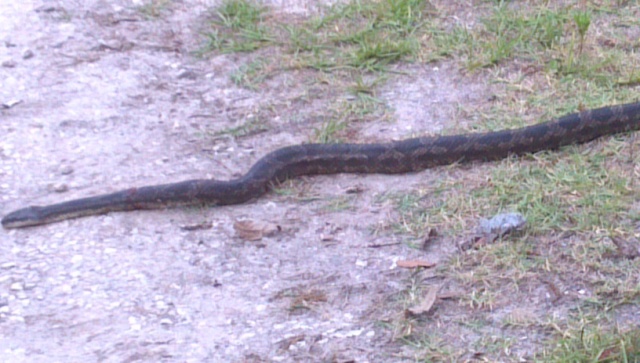 snake curled up in my back tire
Question
pic 1
Hello, I would like to know what
snake curled up in my back tire
Question
pic 1
Hello, I would like to know what
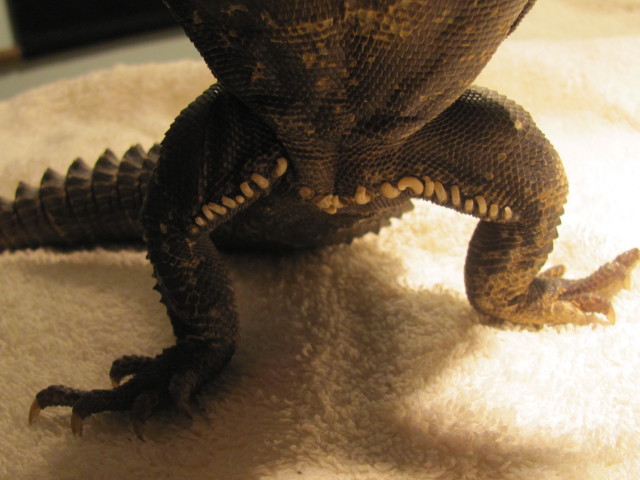 Uro parasite??? Please help
Questionloops
QUESTION: Hi Donna,
Ive had my u
Uro parasite??? Please help
Questionloops
QUESTION: Hi Donna,
Ive had my u
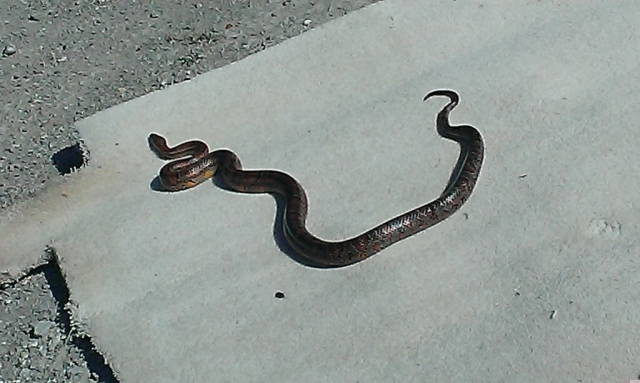 Snake ID
Question
Snake Snake
Can you tell me hat k
Snake ID
Question
Snake Snake
Can you tell me hat k
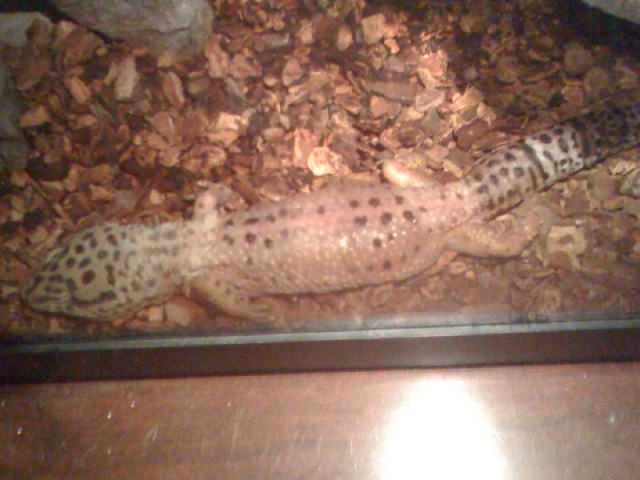 Sunburn leopard Gecko
Question
sick gecko
HELP PLEASE!!!!
I have a 2+
Sunburn leopard Gecko
Question
sick gecko
HELP PLEASE!!!!
I have a 2+
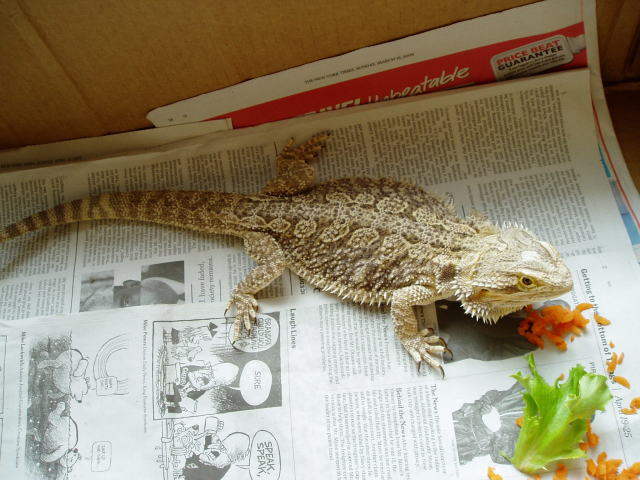 Our New Bearded Dragon
Question
Alley
Hi Diane,
I was wondering if you can hel
Our New Bearded Dragon
Question
Alley
Hi Diane,
I was wondering if you can hel